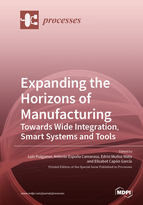Expanding the Horizons of Manufacturing: Towards Wide Integration, Smart Systems and Tools
A special issue of Processes (ISSN 2227-9717). This special issue belongs to the section "Manufacturing Processes and Systems".
Deadline for manuscript submissions: closed (15 December 2021) | Viewed by 116962
Special Issue Editors
Interests: process systems engineering (PSE); chemical processes; process design, synthesis, modelling, simulation, optimization; linear & non-linear processes; batch processes; intelligent manufacturing; knowledge management; circular economy principles in process systems; industrial symbiosis; integrated and sustainable supply-chain planning, scheduling, operational; PSE vs Intelligent manufacturing; knowledge-based recipe management for production processes; sustainable bio-based energy supply chains
Interests: process systems engineering; sustainability and circular economy; artificial intelligence tools for decision-making support
Special Issues, Collections and Topics in MDPI journals
Interests: Formal Knowledge Models; domain ontology development; computational intelligence; process intelligent systems; decision support systems; improved transactional data systems
Interests: process optimization; mathematical programming; process simulation; artificial intelligence; discrete optimization; machine learning; advanced manufacturing
Special Issue Information
Dear Colleagues,
This research topic aims at enterprise-wide modeling and optimization (EWMO) through the development and application of integrated modeling, simulation and optimization methodologies, and computer-aided tools for reliable and sustainable improvement opportunities within the entire manufacturing network (raw materials, production plants, distribution, retailers, and customers) and its components. Such an integrated approach also incorporates information coming from the local basic control and supervisory modules into the scheduling/planning formulation, making it possible to dynamically react to incidents occurring in the network components at the appropriate level of decision-making.
The use of a wide-integrated solution should allow enhanced coordination and cooperation between network components by avoiding competition among them, eventually leading to local optima and inefficiency associated with inconsistent isolated decisions at different levels. Such a wide-integrated solution approach would be providing new structural alternatives, more effective management policies, more economical design options. Moreover, the solution obtained can work in practice requiring fewer resources, emitting less waste, and allowing for better responsiveness in changing market requirements and operational variations, thus leading to reduced cost, waste, energy consumption, and environmental impact and also to increased benefits.
More recently, the exploitation of new technology integration such as through semantic models in the form of formal knowledge models allows capturing and utilizing domain knowledge, human knowledge, and expert knowledge towards wide intelligent management. Otherwise, the development of advanced technologies and tools such as cyberphysical systems, the Internet of Things, the Industrial Internet of Things, Artificial Intelligence, Big Data, Cloud Computing, Blockchain, etc. have captured the attention of manufacturing enterprises towards smart manufacturing systems. This Special Issue also calls for contributions from these advanced areas.
In summary, we look for articles addressing (but not limited to) the following concepts:
- Development of advanced mathematical models and methodologies for the integrated approach of:
- The network design problem, such as the location of the plant, warehouses, and distribution centers, capacity and technology selection, etc.;
- The supply chain planning problem, including distribution planning, inventory control, and product demand forecasting;
- Integration of production, financial and environmental aspects, risk, and uncertainty.
The expected models will tackle a multiobjective view of achieving the necessary trade-off between often contradictory benefits in terms of economic, environmental, customer satisfaction, and increased response to dynamic market changes;
- Development of detailed production scheduling at plant level for batch, continuous and discrete manufacturing for online scheduling implemented in practice under real-time variations and uncertainty;
- Integration of the tracking system of network dynamics within the holistic decision-making model (e.g., by enclosing a model predictive control framework), thus facilitating equipment capacity handling similarly at strategic and operational levels and enabling adequate response to incidents for enhanced production sustainability;
- Development of suitable frameworks and algorithms for solving these problems in an efficient and integrated manner (e.g., surrogate problem decomposition, disjunctive programming, Lagrange decomposition?);
- Development of software prototypes for the implementation of the above methodologies and algorithms, illustrating their applicability in several real-life industrial case studies involving typical manufacturing/distribution networks belonging to relevant sectors in the world;
- Development of novel frameworks focusing on the utilization of formal knowledge models, facilitating new technologies implementation, and transactional system integration;
- Further development of smart manufacturing systems for the transformation of manufacturing enterprises, from traditional to the intellectualized ones;
- Development of Intelligent Systems and Intelligent Agents focused on cooperative work between human beings and computers, enhancing the capability of human decision-making and problem solutions in the process engineering field.
Prof. Dr. Luis Puigjaner
Prof. Dr. Antonio Espuña Camarasa
Dr. Edrisi Muñoz Mata
Dr. Elisabet Capón García
Guest Editors
Manuscript Submission Information
Manuscripts should be submitted online at www.mdpi.com by registering and logging in to this website. Once you are registered, click here to go to the submission form. Manuscripts can be submitted until the deadline. All submissions that pass pre-check are peer-reviewed. Accepted papers will be published continuously in the journal (as soon as accepted) and will be listed together on the special issue website. Research articles, review articles as well as short communications are invited. For planned papers, a title and short abstract (about 100 words) can be sent to the Editorial Office for announcement on this website.
Submitted manuscripts should not have been published previously, nor be under consideration for publication elsewhere (except conference proceedings papers). All manuscripts are thoroughly refereed through a single-blind peer-review process. A guide for authors and other relevant information for submission of manuscripts is available on the Instructions for Authors page. Processes is an international peer-reviewed open access monthly journal published by MDPI.
Please visit the Instructions for Authors page before submitting a manuscript. The Article Processing Charge (APC) for publication in this open access journal is 2400 CHF (Swiss Francs). Submitted papers should be well formatted and use good English. Authors may use MDPI's English editing service prior to publication or during author revisions.
Keywords
- Enterprise-wide integrated modeling, multi-scale optimization
- Advanced mathematical models and methodologies, PSE approach
- Integration of production, financial, environmental, risk, and uncertainty
- Integration of network design and supply chain
- Detailed production and online scheduling
- Integration of tracking system of network dynamics
- Enhancing production sustainability
- Development of suitable frameworks and algorithms
- Software prototypes for real industrial applications
- Development of formal knowledge models development
- Transactional systems integration
- Advanced smart manufacturing systems
- Cooperative intelligent systems and intelligent agents
- Use of new tools, IoT, Big data, cloud computing, cyberphysical systems









